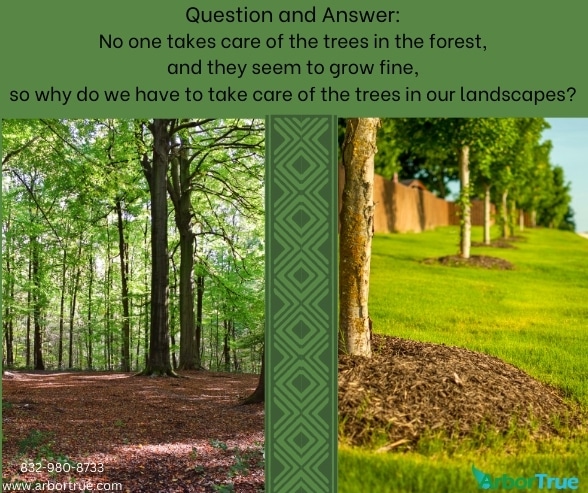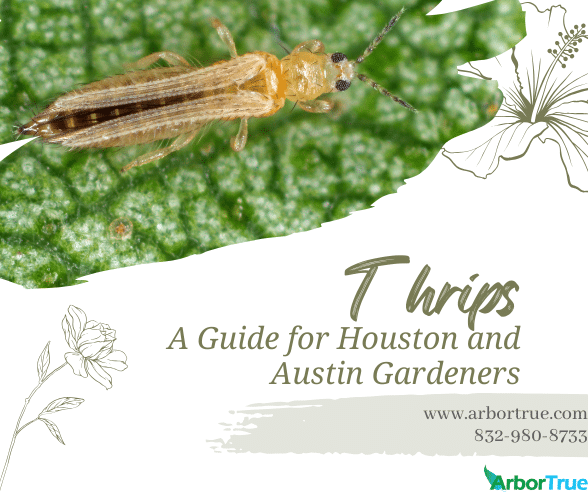
Spring Into Action: A Guest Post from Sienna Mulch
February 14, 2024
Mushroom Monday: King Trumpet Mushrooms (Pleurotus eryngii)
February 19, 2024
Question and Answer: No one takes care of the trees in the forest, and they seem to grow fine, so why do we have to take care of the trees in our landscapes?
We recently had a social media post with a survey asking what people might want to see posts about on our TrueTreeTalk blog. One of things that was requested were posts with questions and answers. With that in mind, here’s a post with a question and an answer.
A question a person might ask is, “No one takes care of the trees in the forest, and they seem to grow fine, so why do we have to take care of the trees in our landscapes?”
There are a lot of reasons why trees in the forest might seem to need less care than trees in landscapes and a lot of reasons why trees in the landscape need care. We go into ten reasons below. These aren’t all the reasons, but just some that can help you understand the difference.
Reason One: Forest trees have leaf litter and other debris left on the soil and landscape trees don’t.
Organisms like fungi in the soil break down organic matter and that allows the nutrients in them to be available for the trees. It is sort of like a natural fertilizer. In a landscape, generally, leaf litter and other debris are removed. This means that trees lose the nutrients that went into their leaves and branches that fall.
Reason Two: Forest trees don’t have to compete with turf grass the way landscape trees do.
Turf grass can absorb a lot of water and nutrients from the soil making conditions more difficult for landscape trees.
Reason Three: Forest trees can be more likely to be native or naturalized trees.
While landscape trees can also be native or naturalized, you might also find trees that aren’t. These trees might require special care to be able to do well in an area that is different from where they are native to.
Reason Four: Forest trees don’t have to deal with lawn fertilizer, herbicides, pesticides, and pollutants the same way landscape trees do.
These different chemicals and compounds can harm a tree. Forest trees might encounter these things less than landscape trees do.
Reason Five: Forest trees don’t have to deal with damage from things like lawn equipment.
Lawn mowers, string trimmers, and other equipment can damage a tree in the landscape if care is not taken.
Reason Six: Forest trees can have a different soil than soil in landscapes.
We’ve had posts about loam and humus. Loam and humus can be more prevalent in forests than they can be in landscapes. In landscapes, the native soil can be disturbed, compacted, removed, and or replaced. This can have an impact on landscape trees.
Reason Seven: Forest trees don’t have to deal with things like concrete and structures that impede their roots and prevent water from getting into the soil.
In landscapes, it is not uncommon for a tree to be right next to a patio, driveway, road, or building. The concrete, asphalt, and foundations from these things can impede tree roots and prevent water from getting to them.
Reason Eight: Forest trees don’t have to deal with things that are done incorrectly, like incorrectly applied mulch or incorrect pruning.
Although a person might be well intentioned, an unknowledgeable person can sometimes do more harm than good when trying to take of their trees. A person could plant a tree incorrectly, trim one in the wrong way, or prune one in a way that damages it. This is why we recommend contacting a professional like those at ArborTrue. A professional can ensure that the work is handled in the correct way.
Reason Nine: Forest trees can have more beneficial fungi growing around them.
We’ve had a lot of information on our blog about mushrooms. In those posts we’ve written about mushrooms that have a mycorrhizal relationship with trees. This type of relationship can be very beneficial, and in some cases necessary, for trees. Additionally, mushrooms that are saprophytes are important in the forest as they decompose dead and decaying organic matter that trees can then get nutrients from. In a landscape, mushrooms like these can be less prevalent, providing less benefit for trees.
Reason Ten: Forests can have greater biodiversity than landscapes.
In landscapes, it’s not uncommon to see many of the same kind of tree or other plant planted together. While this may look nice, it can cause issues when it comes to disease and how many plants are impacted by negative conditions. When trees are all the same, they might all get the same disease or be impacted in similar ways by negative conditions. The biodiversity of a forest can help alleviate some of this. Because a landscape may have many of the same kind of tree, they might need more care than comparable trees in a forest.
Because landscape trees require care, we recommend having an arborist examine the trees in your landscape at least once per year so you can know more about their condition and so a plan for their care can be developed. Late winter/early spring is a good time of year for things like deep root fertilization, canopy spray with RP bacteria, and applying fertilizer for palms, and an arborist can help determine what is right for your trees.




